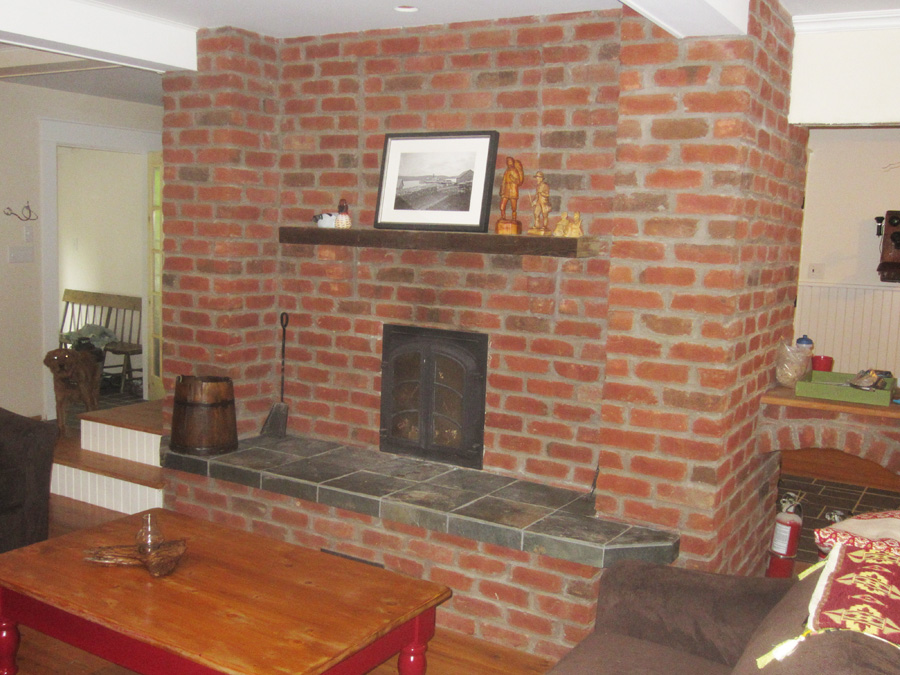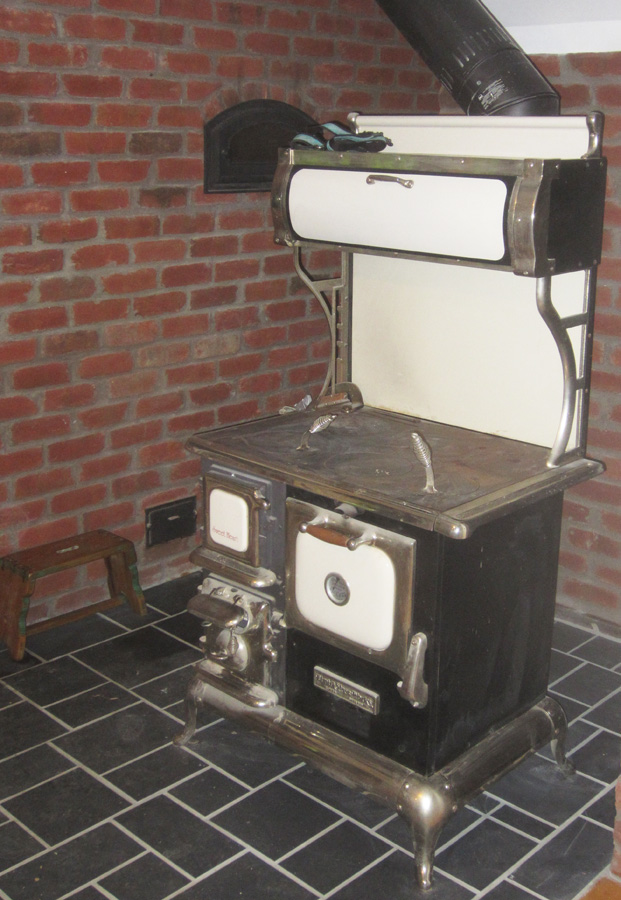The principal source of heat for the building is a dual-stack Finnish contra-flow masonry heater. The core was constructed by Norbert Senf and the masonry cladding was built by Longchamps et fils. Masonry heaters are the cleanest burning most-efficient whole house wood-fuel space heaters available, with a remarkable track record of home heating extending back centuries in Russia and Scandinavia. Masonry heaters in North America are larger in scale than their European counterparts due to the larger homes that are prevalent here.
Masonry heaters rely on relatively short hot fires (hence thorough combustion and low emissions) of cordwood fuel. The flue gases are routed by channels back down the masonry mass before exiting to the chimney. Much of the combustion heat is thus transferred into the masonry mass. The warm (never hot) exterior surface of the masonry heater then slowly reradiates this heat as long wavelength infrared into the house. Unlike a wood stove whose hot outer surface is radiating heat at shorter wavelengths, thereby losing a significant portion of its heat to air molecules near the stove, the longer wavelength infrared from a masonry heater reaches further into the house. A single load of 20kg of cordwood is generally sufficient to heat the house for 24 hours. Only in the coldest temperatures would a second fire be required.
The heater is centrally placed in the house so that its heat is distributed most effectively and uniformly. The main floor follows a fairly open plan and the heater should very comfortably heat the living room, dining room and kitchen areas. The heating of closed off rooms depends on the absorption and re-radiation of heat by walls, furniture etc., but this heat transfer process is less efficient and decreases quite dramatically the further away the room is from the radiant source. A degree of secondary heat transfer occurs as air is convected past the masonry surface, where it is warmed, and then rises to the second floor.
The Solarhurst design has incorporated several features that we hope will prove effective at delivering some more of the masonry heat energy to more distant parts of the house.
- we have extended the masonry mass to the second floor (in essence a chase for the chimney) and this should serve as a radiant surface (albeit weaker) benefiting the second floor.
- we have constructed partial brick walls on the main downstairs bedroom and the master upstairs bedroom. These walls are extensions of the masonry heater and hopefully will serve as re-radiant surfaces, as they themselves gain heat.
- a sizeable area around the masonry heater and adjoining stair well is open to the second floor. As well key rooms upstairs have strategically located floor registers/vents. Both should aid convective heat transfer to the upstairs.
- two ceiling fans in the upstairs hallway will redirect hotter air into adjoining rooms (assuming doors are open).
- a second masonry heater has been placed in the basement, for heating that space. If fired, some of its radiant heat will be transferred to the floor of the main level.
- duct work associated with the hi-velocity forced air system will have return vents just above the basement and the main floor masonry heaters. Simple fan circulation should effectively distribute warmer air to key rooms, selected by using a “zoned system” of automatic duct dampers.

There are two downsides to masonry heaters, above and beyond their initial cost. Because there is so much thermal mass, they are slow to gain heat, and hence slow to heat a house.
A house starting at 5oC on Friday night, may only start to feel comfortable by Monday.
Auxiliary and more quick acting air-heating devices may be required if the masonry heater has not been fired in a long time (see below). The second issue is that of fuel convenience. Cordwood, even if supplied in split face cords, is cumbersome, and becomes problematic with age and/or illness.
We are modifying the downstairs masonry heater to burn (in bulk – 15 kg per burn) wood pellets. Pellets are a by-product of the lumber industry and are made up of compressed sawdust, material that would otherwise be burned industrially, used as mulch, or end up in landfill. The density of pellets is such that a smaller volume will yield the same BTU’s of heat as a larger load of cordwood. They are also the cleanest burning of all wood fuels (partly due to their low moisture content (6% vs 17% in seasoned cordwood) and as a consequence of their derivation from debarked wood. The pellets should prove much easier to store and handle.
Auxiliary Heating
Wood cookstove. The kitchen will also feature a wood cookstove which will be both a backup range (to the propane stove), and a space heater when either small fires are required (say to take the chill off in the morning of what will be a warm Fall day), or when the house needs to be warmed from a cold start.

Electric Furnace Forced Air: We are installing a Hi-Velocity forced air system that includes a small electric furnace. Hopefully there will be little requirement to use the electric furnace, but if certain parts of the house are not being adequately heated, then the furnace will be used to help heat specific parts of the house using a zoned damper system.
The electric furnace will also be the only system available to us (with the exception of portable electric heaters) to keep the house from freezing, in our absence. In truth we plan to allow the house to return to ambient (outside) temperatures, with plumbing designed to be easily drained to avoid freezing damage. WHY HEAT THE HOUSE IF YOU ARE NOT THERE!
